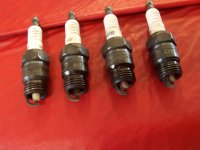case12
Well-known member
As normal, I crank my 'Stangs in storage once a month in the winter and let them run for 30mins. This time my GT/CS starts smoking blue smoke (oil) on one side (passenger side). It was doing this just a barely perceivable amount in the summer - but now it is really puffing. It puffs blue smoke on idle and when I rev it to higher RPMs, even after it is warm.
Any ideas what I should do to check this out?
Some background. 289, Edlebrock 4 barrel and intake - otherwise stock. Heads and valves redone (with hardened seals) about 1.5 years ago. Compression check out fine when I adjusted the valves then. (as a note, I did have some trouble setting the valves on this side to keep the rocker/push rod noise down - but no smoking then). Maybe 200 miles on the new heads. Here are pictures of the plugs - they look pretty good to me...
Thanks for any ideas to check next. Casey
Any ideas what I should do to check this out?
Some background. 289, Edlebrock 4 barrel and intake - otherwise stock. Heads and valves redone (with hardened seals) about 1.5 years ago. Compression check out fine when I adjusted the valves then. (as a note, I did have some trouble setting the valves on this side to keep the rocker/push rod noise down - but no smoking then). Maybe 200 miles on the new heads. Here are pictures of the plugs - they look pretty good to me...
Thanks for any ideas to check next. Casey

